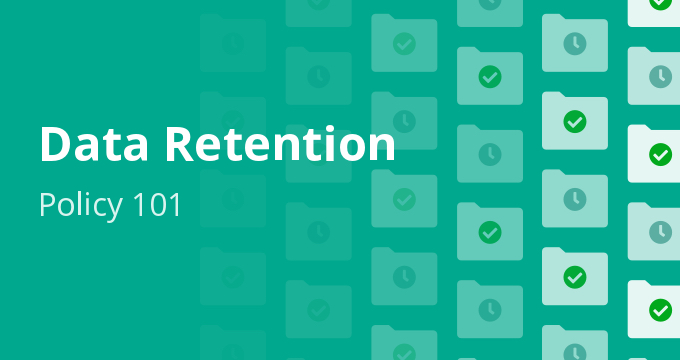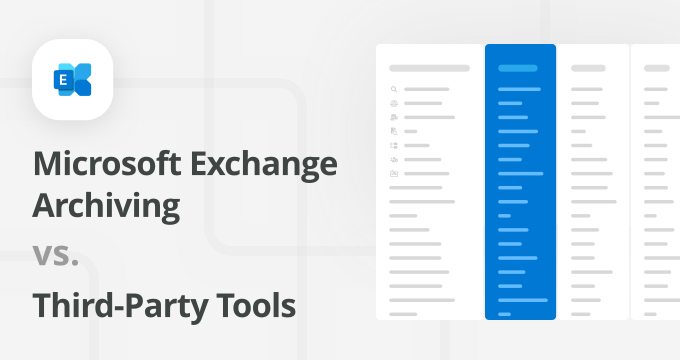Understanding and implementing an effective document retention policy is crucial for any organization, particularly when it comes to responding to requests for production in legal and compliance contexts.
In this article, we’ll cover:
- The essentials of policy creation,
- The impact of technology in document management, and
- How to navigate legal requirements effectively.
Whether you’re an IT Director, Technology Manager, CIO, CTO, or Compliance Officer in sectors like K-12 Education, Financial Services, Government, or Healthcare, this guide aims to provide clear, actionable insights for mastering these key aspects of data management.
Understanding Document Retention Policy
Definition and purpose
A document retention policy is a systematic approach to managing company records. It dictates how long different types of documents should be kept and outlines the procedures for disposing of records once they are no longer needed.
The purpose of such a policy goes beyond mere organization. It ensures compliance with legal and regulatory requirements, aids in the efficient management of company resources, and plays a critical role in litigation and audit readiness.
Key components of an effective document retention policy
- Identifying documents that need to be retained, ranging from emails and contracts to employee records and financial statements.
- Determining the retention period for each type of document, which can vary based on legal requirements, industry standards, and business needs.
- Establishing protocols for secure storage, access, and eventual disposal of documents, ensuring both safety and confidentiality.
Legal and compliance implications
Various laws and regulations, like HIPAA for healthcare, FERPA for educational institutions, and Sarbanes-Oxley for public companies, dictate specific requirements for document retention.
Failure to comply with these regulations can result in legal penalties, financial losses, and reputational damage. An effective document retention policy helps mitigate these risks by ensuring regulatory compliance.
The role of technology in document retention
Managing documents electronically through digital archiving solutions is becoming the norm. Benefits of using digital archiving tools include:
- Enhanced Efficiency —Streamlined storage, retrieval, and management of digital records.
- Improved Accessibility — Easy access to archived documents with advanced search capabilities.
- Cost-Effective — Reduced expenses compared to physical storage solutions.
- Secure Data Management — Robust security features like encryption and access controls.
- Regulatory Compliance — Features supporting GDPR, HIPAA, and other data protection laws.
- Automated Retention Schedules — Simplified adherence to legal and organizational retention requirements.
- Space Conservation — Reduced physical storage space requirements.
- Disaster Recovery — Enhanced data protection against natural disasters and data breaches.
- Environmental Benefits — Less paper usage contributes to eco-friendly practices.
Managing Requests for Production
Definition and purpose
Requests for production are legal demands for documents, often occurring during litigation or compliance investigations. They require an organization to produce specific documents relevant to a case or inquiry.
These requests are common in legal disputes, audits, and compliance reviews, where proving adherence to regulations or resolving disputes hinges on the availability and accuracy of documentation.
Legal requirements and obligations
When it comes to the legal requirements and obligations associated with requests for production of documents, organizations need to navigate a complex landscape with precision and care.
Here’s an expanded view of these requirements:
- Timeliness of Response: Legal requests for production typically come with strict deadlines. Organizations must respond within the specified timeframe to avoid legal repercussions such as sanctions or contempt of court charges.
- Completeness and Accuracy: It’s imperative to provide complete and accurate documents as requested. Incomplete submissions or wrong information can lead to accusations of non-compliance or, worse, evidence tampering.
- Scope of Document Production: Requests for production often encompass a wide range of documents, from digital communications like emails and instant messages to contracts and employee records.
- Privileged Information: Certain documents may be protected under legal privileges, such as attorney-client communications. Organizations must identify and appropriately handle such documents to avoid unintentional waiver of privilege.
- Data Privacy Considerations: When producing documents, organizations must be mindful of privacy laws. This involves redacting sensitive personal information in compliance with regulations like GDPR or HIPAA to prevent privacy breaches.
- Legal Hold Procedures: Upon receiving a request for production of documents, organizations often need to implement a legal hold. This procedure ensures that relevant documents are preserved and can’t be altered or destroyed, even if they fall beyond the standard retention period.
- Collaboration with Legal Teams: Legal teams can provide guidance on the nuances of the request, help identify relevant documents, and ensure that the response aligns with legal obligations.
By adhering to these requirements and obligations, organizations can effectively manage requests for production of documents, minimizing legal risks and upholding their reputational integrity.
Rule 34 of Federal Rules of Civil Procedure (FRCP)
In the United States, one example of a rule pertaining to the Request for Production of Documents can be found in the Federal Rules of Civil Procedure (FRCP). Specifically, Rule 34 of the FRCP addresses this aspect.
Rule 34 allows a party to serve on any other party a request to produce and permit the requesting party or its representative to inspect, copy, test, or sample the items in the responding party’s possession, custody, or control.
The requested items must be described with reasonable particularity, and the request must specify a reasonable time, place, and manner for the inspection and for performing the related acts.
Moreover, Rule 34 also requires the party to whom the request is directed to respond in writing within 30 days after being served, stating whether the party will comply with the request or object to it. If objections are made, the reasons for them must be stated.
This rule is essential in civil litigation as it provides a mechanism for parties to obtain necessary evidence from each other.
Responding to requests for production (step-by-step guide)
Navigating the complexities of a request for production demands a strategic and methodical approach. This step-by-step guide is designed to help organizations respond effectively, ensuring legal compliance and minimizing potential disruptions.
Step 1: Immediate assessment
Upon receiving a request for production of documents, promptly assess its scope. Identify the specific types of documents requested and note any deadlines.
Step 2: Consult legal experts
Quickly involve your legal team or seek external legal counsel. This is crucial for interpreting the request accurately and understanding your legal obligations.
Step 3: Implement a legal hold
Prevent any alteration or destruction of potentially relevant documents by initiating a legal hold. This action is essential to preserve all documents that might be pertinent to the request.
Step 4: Gather relevant documents
Start the process of gathering all documents that fall within the scope of the request. This may involve coordinating with various departments and utilizing eDiscovery tools for efficiency.
Step 5: Review for compliance and relevance
Carefully review the collected documents to ensure they meet the criteria of the request and comply with legal standards. Pay special attention to confidentiality and privilege issues.
Step 6: Organize and prepare documentation
Organize the documents in a manner that aligns with the request’s specifications. Prepare them for delivery, ensuring they are complete, accurate, and in the required format.
Step 7: Submit the response
Deliver the documents to the requesting party by the specified deadline. Ensure that the delivery method is secure and verifiable.
Step 8: Document the Process
Maintain a comprehensive record of all steps taken in response to the request, including decisions made, persons involved, and the documents provided. This documentation is vital for accountability and future reference.
By following these steps, organizations can confidently manage requests for production of documents, upholding legal standards and maintaining operational integrity.
Jatheon’s cloud email archiving solution can help you capture data automatically, find important information, and manage your data with ease.
Conclusion
By understanding the importance of a robust document retention policy, leveraging technology effectively, and following a structured approach to requests for production, organizations can mitigate risks and maintain compliance.
The key is to strike a balance between retaining necessary documents for legal and business purposes and respecting privacy laws that require the disposal of unnecessary data.
FAQ
How often should a document retention policy be reviewed?
A document retention policy should be reviewed annually or whenever there are significant changes in legal requirements, technology, or business operations.
What are the typical penalties for failing to comply with document retention laws?
Penalties can range from fines and legal sanctions to imprisonment, depending on the severity of the violation and the specific laws involved.
For instance, under the Sarbanes-Oxley Act, improper destruction, alteration, or falsification of records in certain circumstances, including federal investigations and bankruptcy cases, can result in fines and imprisonment for up to 20 years.
Can small businesses be exempt from certain document retention regulations?
While some regulations may have different requirements for small businesses, generally, all organizations are subject to document retention laws relevant to their industry and operations.
How should an organization handle conflicting requirements between data retention and data privacy laws?
Organizations should consult with legal counsel to develop a document retention policy that balances the requirements of both data retention and data privacy laws, considering industry-specific regulations and the jurisdictions in which they operate.











